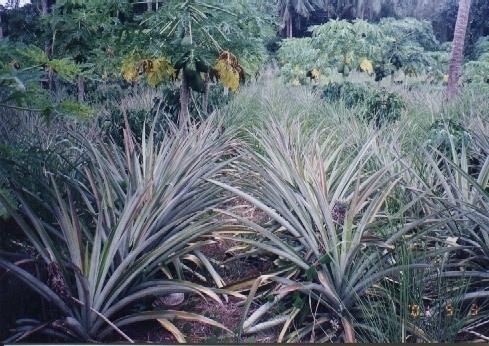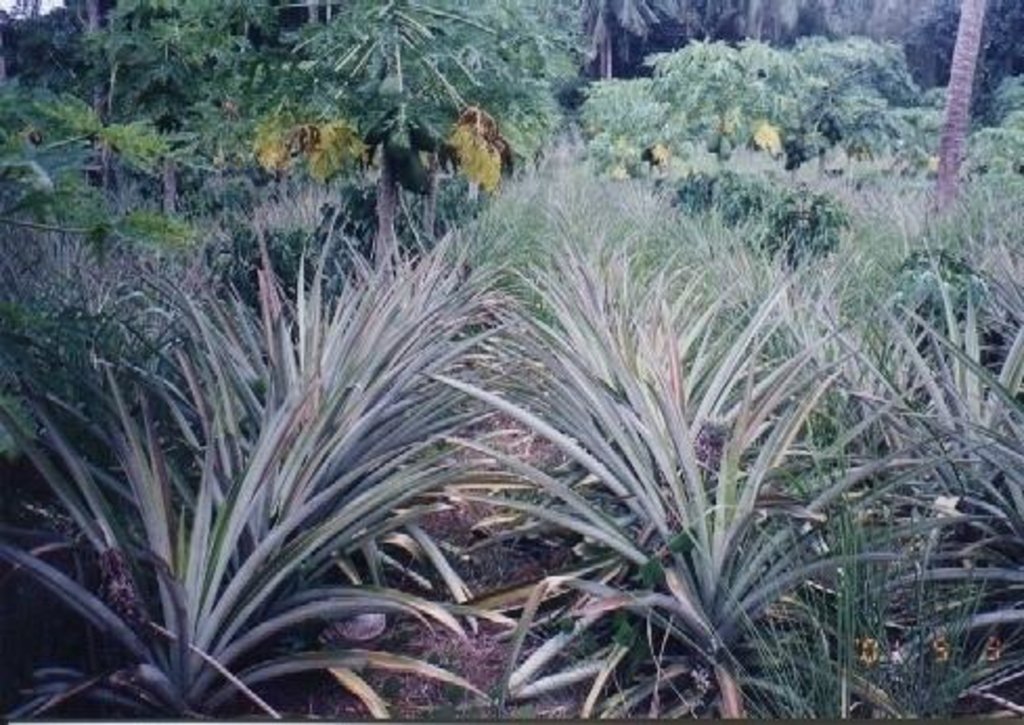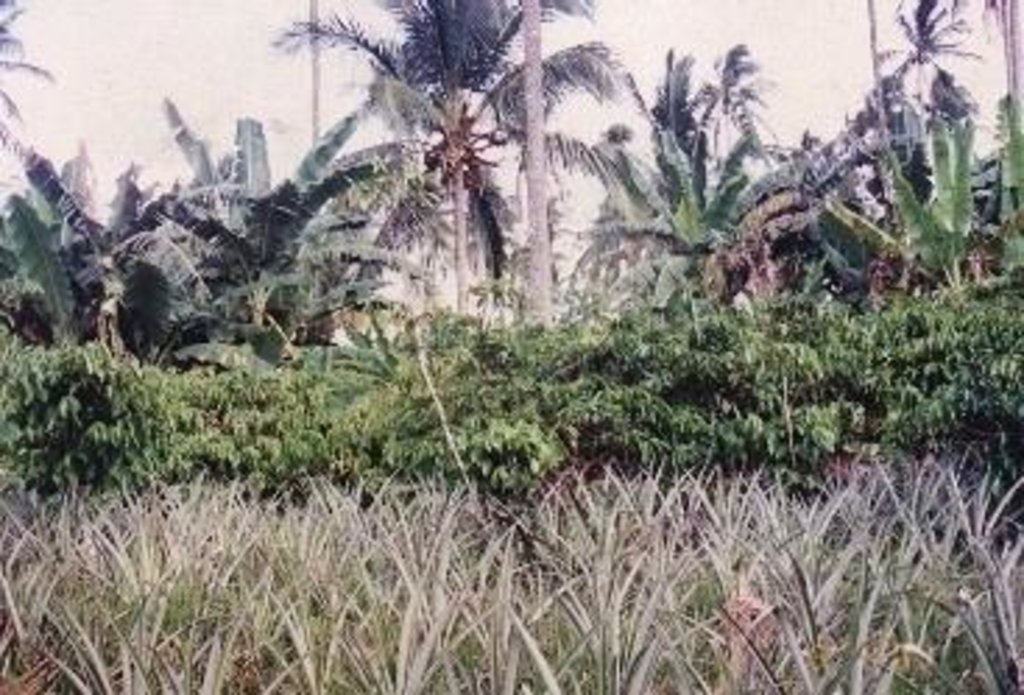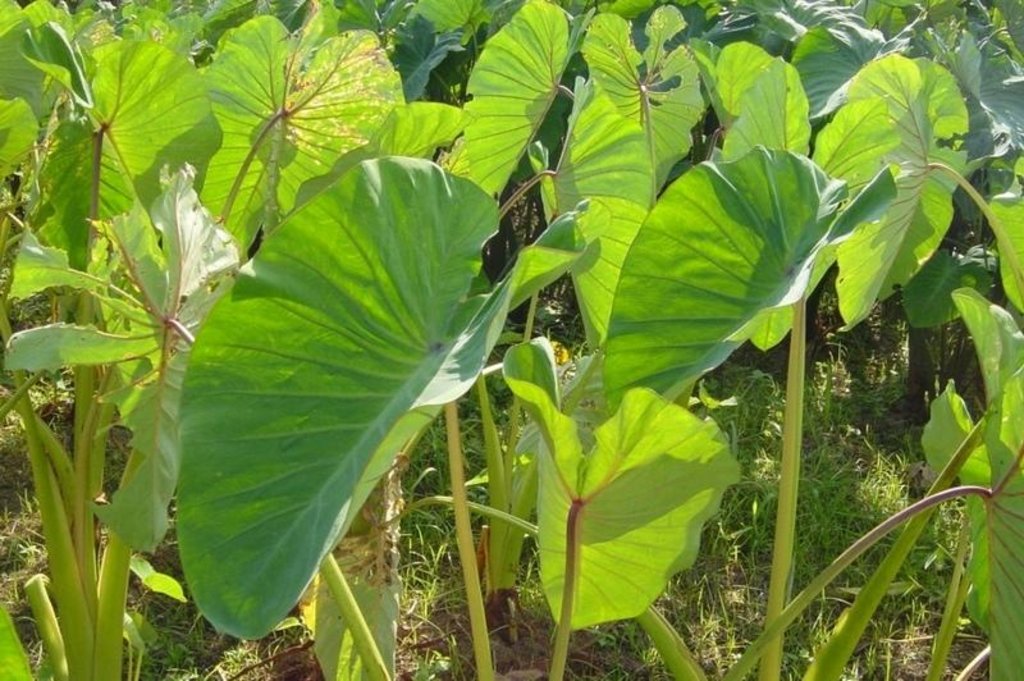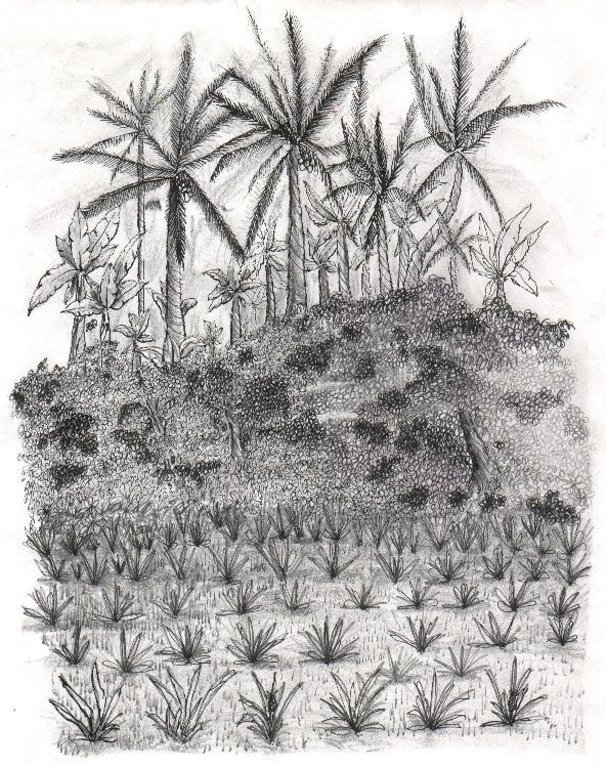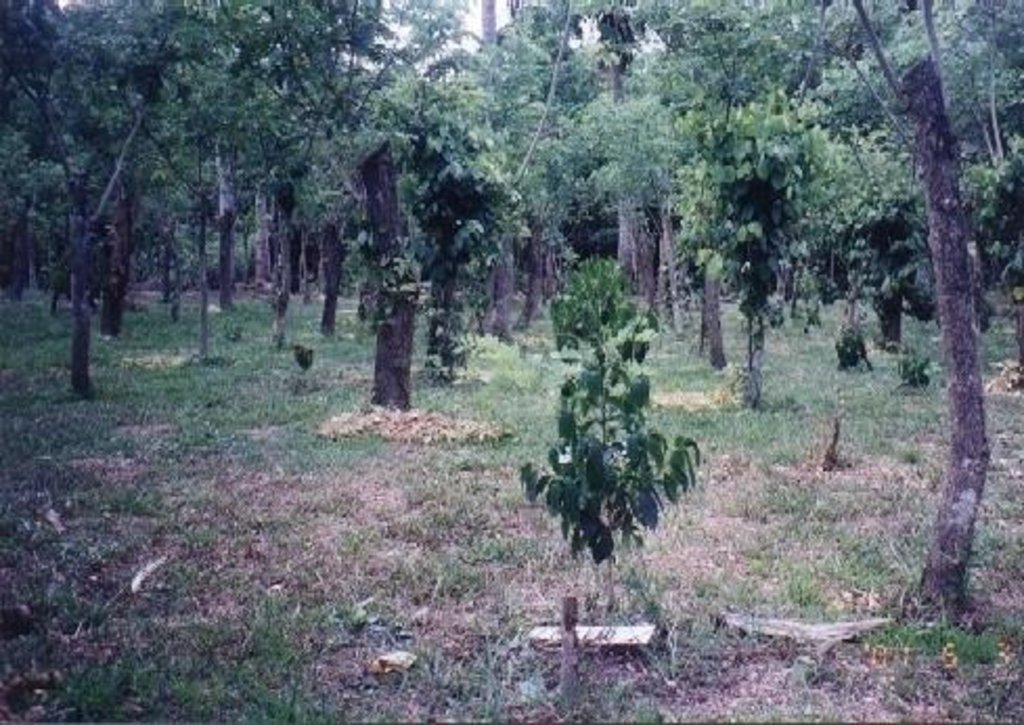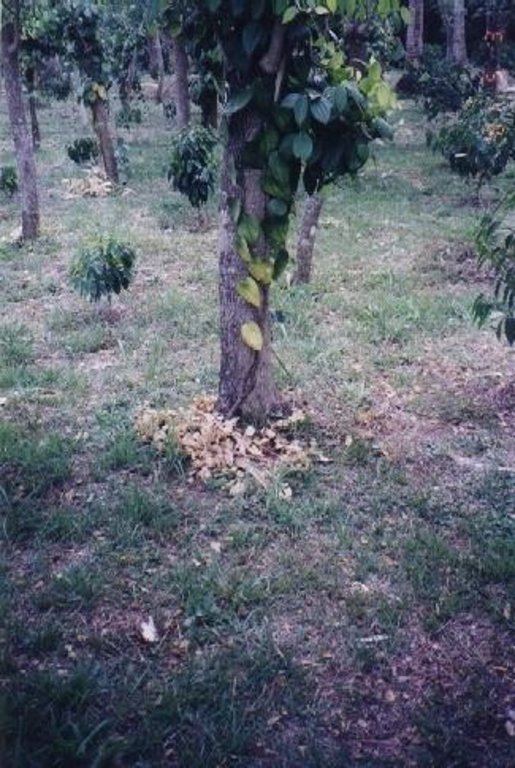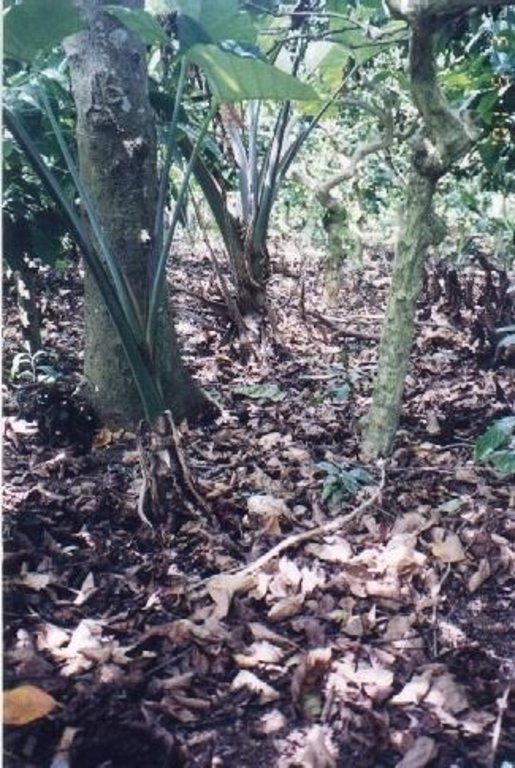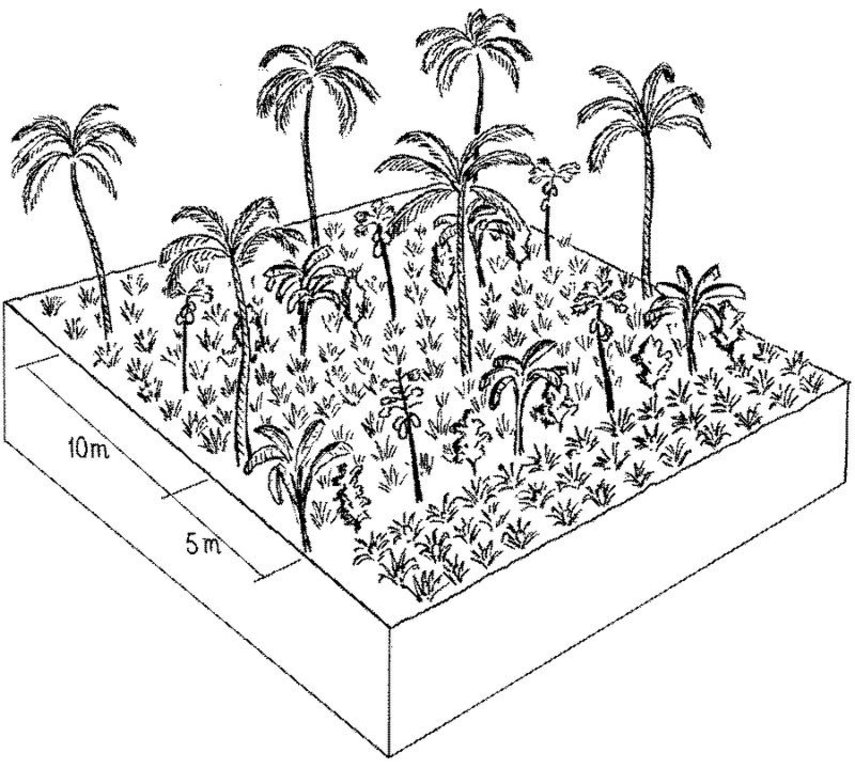Multi-Storey Cropping [ฟิลิปปินส์]
- ผู้สร้างสรรค์:
- การอัพเดท:
- ผู้รวบรวม: Philippine Overview of Conservation Approaches and Technologies
- ผู้เรียบเรียง: –
- ผู้ตรวจสอบ: Deborah Niggli, Alexandra Gavilano
Maramihang Pagtatanim or Planting in Great Numbers
technologies_1103 - ฟิลิปปินส์
ดูส่วนย่อย
ขยายทั้งหมด ย่อทั้งหมด1. ข้อมูลทั่วไป
1.2 รายละเอียดที่ติดต่อได้ของผู้รวบรวมและองค์กรที่เกี่ยวข้องในการประเมินและการจัดเตรียมทำเอกสารของเทคโนโลยี
ผู้เชี่ยวชาญ SLM:
Rondal Jose
Bureau of Soils and Water Management
ฟิลิปปินส์
ผู้เชี่ยวชาญ SLM:
Mojica Alejandro
Cavite State University
ฟิลิปปินส์
ผู้เชี่ยวชาญ SLM:
Rojales Joseph
Bureau of Soils and Water Management
ฟิลิปปินส์
ชื่อของโครงการซึ่งอำนวยความสะดวกในการทำเอกสารหรือการประเมินเทคโนโลยี (ถ้าเกี่ยวข้อง)
Book project: where the land is greener - Case Studies and Analysis of Soil and Water Conservation Initiatives Worldwide (where the land is greener)ชื่อขององค์กรซึ่งอำนวยความสะดวกในการทำเอกสารหรือการประเมินเทคโนโลยี (ถ้าเกี่ยวข้อง)
Bureau of Soils and Water Management (Bureau of Soils and Water Management) - ฟิลิปปินส์ชื่อขององค์กรซึ่งอำนวยความสะดวกในการทำเอกสารหรือการประเมินเทคโนโลยี (ถ้าเกี่ยวข้อง)
Cavite State University (CvSU) - ฟิลิปปินส์ชื่อขององค์กรซึ่งอำนวยความสะดวกในการทำเอกสารหรือการประเมินเทคโนโลยี (ถ้าเกี่ยวข้อง)
Farming Systems and Soil Resources Institute, University of the Philippines Los (Farming Systems and Soil Resources Institute, University of the Philippines Los) - ฟิลิปปินส์1.3 เงื่อนไขการใช้ข้อมูลที่ได้บันทึกผ่านทาง WOCAT
ผู้รวบรวมและวิทยากรหลักยอมรับเงื่อนไขเกี่ยวกับการใช้ข้อมูลที่ถูกบันทึกผ่านทาง WOCAT:
ใช่
1.4 การเปิดเผยเรื่องความยั่งยืนของเทคโนโลยีที่ได้อธิบายไว้
เทคโนโลยีที่ได้อธิบายไว้นี้เป็นปัญหาของความเสื่อมโทรมโทรมของที่ดินหรือไม่ จึงไม่ได้รับการยอมรับว่าเป็นเทคโนโลยีเพื่อการจัดการที่ดินอย่างยั่งยืน:
ไม่ใช่
2. การอธิบายลักษณะของเทคโนโลยี SLM
2.1 การอธิบายแบบสั้น ๆ ของเทคโนโลยี
คำจำกัดความของเทคโนโลยี:
Cultivating a mixture of crops with different heights (multi-storey) and growth characteristics which together optimise the use of soil, moisture and space.
2.2 การอธิบายแบบละเอียดของเทคโนโลยี
คำอธิบาย:
Under the maramihang pagtatanim multi-storey cropping system, perennial crops (coconut, banana, coffee, papaya, pineapple) and annuals/biennials (root crops: taro, yam, sweet potato etc) are interplanted to maximise productivity and income. This is most applicable where farms are small and the system needs to be intensive. In this particular area, Cavite, coconuts are usually planted first. When they reach a height of 4.5 meters (after 3-4 years), bananas, coffee and/or papaya are planted underneath. Black pepper may also be part of the system. After sufficient space has developed at ground level in about three to four years, root crops are planted. At full establishment, the system develops different layers: coconut (tallest) followed by banana, coffee, papaya (middle), root crops and pineapple (lowest). In recent years, because of its relatively low productivity and decreasing price, coconut has tended to be replaced in the system with higher value crops like the fruit tree santol (Sandoricum koetjape), papaya and sometimes black pepper. However most multi-storey farms adhere to no specific planting layout. The multi-storey agroforestry system is intended to make the best use of resources (soil, moisture and space) for increased farm income. It is also very effective against soil erosion. Previously, continuous monocropping of annual crops resulted in erosion and serious soil fertility decline. Even though the land is sloping and rainfall during the monsoon is extremely intensive, multi-storey cropping provides adequate soil cover throughout the year, protecting the land from erosion.
Fertilization, weeding and pruning are necessary elements of maintenance. ‘Natural’ mulching through fallen leaves from leguminous trees helps restore and maintain soil fertility The system is applied in a volcanic-derived soil with distinct wet and dry periods (6 months wet season, 6 months dry season). There is the risk of a destructive typhoon every 10 years. Farm income is relatively high, but labour and input costs are also high - and the technology is mostly used by relatively wealthy landowners. There is strong spontaneous adoption, as maramihang pagtatanim has been proven to be effective and remunerative. This technology has been practiced in Cavite since the 1970s. Implementation is by individual farmers with strong extension support from the Local Government Units (LGUs), NGOs and the Cavite State University.
2.3 รูปภาพของเทคโนโลยี
2.5 ประเทศภูมิภาค หรือสถานที่ตั้งที่เทคโนโลยีได้นำไปใช้และได้รับการครอบคลุมโดยการประเมินนี้
ประเทศ:
ฟิลิปปินส์
ภูมิภาค/รัฐ/จังหวัด:
Philippines, Cavite
ข้อมูลจำเพาะเพิ่มเติมของสถานที่ตั้ง :
Cavite
ระบุการกระจายตัวของเทคโนโลยี:
- กระจายไปอย่างสม่ำเสมอในพื้นที่
If the Technology is evenly spread over an area, specify area covered (in km2):
40.0
If precise area is not known, indicate approximate area covered:
- 10-100 ตร.กม.
แสดงความคิดเห็น:
Total area covered by the SLM Technology is 40 km2.
Six adjacent municipalities are practicing multi-storey cropping as a system. This is meant to increase income particularly for small farmers.
Map
×2.6 วันที่การดำเนินการ
ถ้าไม่รู้ปีที่แน่นอน ให้ระบุวันที่โดยประมาณ:
- มากกว่า 50 ปี (แบบดั้งเดิม)
2.7 คำแนะนำของเทคโนโลยี
ให้ระบุว่าเทคโนโลยีถูกแนะนำเข้ามาอย่างไร:
- เป็นส่วนหนึ่งของระบบแบบดั้งเดิมที่ทำก้นอยู่ (> 50 ปี)
ความคิดเห็น (ประเภทของโครงการ เป็นต้น) :
It evolved in the area due to necessity.
3. การจัดประเภทของเทคโนโลยี SLM
3.1 วัตถุประสงค์หลักของเทคโนโลยี
- ปรับปรุงการผลิตให้ดีขึ้น
- ลด ป้องกัน ฟื้นฟู การเสื่อมโทรมของที่ดิน
3.2 ประเภทของการใช้ที่ดินในปัจจุบันที่ได้นำเทคโนโลยีไปใช้
Land use mixed within the same land unit:
ใช่
Specify mixed land use (crops/ grazing/ trees):
- วนเกษตร (Agroforestry)

พื้นที่ปลูกพืช
จำนวนของฤดูเพาะปลูกต่อปี:
- 2
ระบุ:
Longest growing period in days: 240, Longest growing period from month to month: May - Jan; Second longest growing period in days: 210, Second longest growing period from month to month: May - Dec

ป่า/พื้นที่ทำไม้
แสดงความคิดเห็น:
Major land use problems (compiler’s opinion): Productivity decline, unstable prices of agricultural products and high costs of inputs are the main land use problems. Inputs also have to be increased to maintain the same yield level in annual cropping systems. There is a severe land use competition: a large proportion of the land is being converted to non-agricultural uses, especially residential and industrial areas because of the proximity to the rapidly expanding capital.
Major land use problems (land users’ perception): Productivity decline and unfavourable prices of agricultural products. High costs of inputs.
3.4 การใช้น้ำ
การใช้น้ำของที่ดินที่มีการใช้เทคโนโลยีอยู่:
- จากน้ำฝน
3.5 กลุ่ม SLM ที่ตรงกับเทคโนโลยีนี้
- การปลูกป่าร่วมกับพืช
- การปรับปรุงดิน / พืชคลุมดิน
3.6 มาตรการ SLM ที่ประกอบกันเป็นเทคโนโลยี

มาตรการจัดการพืช
- A1: พืช/สิ่งปกคลุมดิน
- A2: อินทรียวัตถุในดิน/ความอุดมสมบูรณ์ในดิน
3.7 รูปแบบหลักของการเสื่อมโทรมของที่ดินที่ได้รับการแก้ไขโดยเทคโนโลยี

การกัดกร่อนของดินโดยน้ำ
- Wt (Loss of topsoil): การสูญเสียดินชั้นบนหรือการกัดกร่อนที่ผิวดิน

การเสื่อมโทรมของดินทางด้านเคมี
- Cn (Fertility decline): ความอุดมสมบูรณ์และปริมาณอินทรียวัตถุในดินถูกทำให้ลดลงไป (ไม่ได้เกิดจากสาเหตุการกัดกร่อน)
3.8 การป้องกัน การลดลง หรือการฟื้นฟูความเสื่อมโทรมของที่ดิน
ระบุเป้าหมายของเทคโนโลยีกับความเสื่อมโทรมของที่ดิน:
- ป้องกันความเสื่อมโทรมของที่ดิน
- ลดความเสื่อมโทรมของดิน
4. ข้อมูลจำเพาะด้านเทคนิค กิจกรรมการนำไปปฏิบัติใช้ ปัจจัยนำเข้า และค่าใช้จ่าย
4.1 แบบแปลนทางเทคนิคของเทคโนโลยี
ข้อมูลจำเพาะด้านเทคนิค (แบบแปลนทางเทคนิคของเทคโนโลยี):
Multi-storey cropping includes various species interplanted systematically to optimise use of resources: pineapple and other
root crops (lowest storey); rows of banana trees, coffee and papaya (middle storey); rows of coconut (highest storey). Note: in practice farmers adjust this layout to meet their needs.
Technical knowledge required for field staff / advisors: moderate
Technical knowledge required for land users: moderate
Main technical functions: control of raindrop splash, improvement of ground cover
Secondary technical functions: control of dispersed runoff: retain / trap, increase in organic matter
Mixed cropping / intercropping
Material/ species: coconut, papaya, coffee, banana, pineapple, black pepper, taro, yam...
Quantity/ density: 2500
Remarks: in rows random
Vegetative measure: tree/shrub cover (multi-storey, aligned)
Vegetative material: F : fruit trees / shrubs
Vegetative measure: Vegetative material: F : fruit trees / shrubs
Fruit trees / shrubs species: coconut, coffee, banana, pineapple, black pepper
ผู้เขียน:
Mats Gurtner
4.2 ข้อมูลทั่วไปเกี่ยวกับการคำนวณปัจจัยนำเข้าและค่าใช้จ่าย
อื่นๆ หรือสกุลเงินประจำชาติ (ระบุ):
Peso
If relevant, indicate exchange rate from USD to local currency (e.g. 1 USD = 79.9 Brazilian Real): 1 USD =:
50.0
ระบุค่าเฉลี่ยของค่าจ้างในการจ้างแรงงานต่อวัน:
3.00
4.3 กิจกรรมเพื่อการจัดตั้ง
| กิจกรรม | Timing (season) | |
|---|---|---|
| 1. | 1. Planting of tallest storey (coconut). | early rainy season |
| 2. | 2. Planting of middle storey (coffee and banana). | early rainy season |
| 3. | 3. Planting of lowest storey (pineapple). | early rainy season |
| 4. | 4. Planting of lowest storey continued (root crops). | early rainy season |
4.4 ค่าใช้จ่ายของปัจจัยนำเข้าที่จำเป็นสำหรับการจัดตั้ง
| ปัจจัยนำเข้า | หน่วย | ปริมาณ | ค่าใช้จ่ายต่อหน่วย | ค่าใช้จ่ายทั้งหมดต่อปัจจัยนำเข้า | %ของค่าใช้จ่ายที่ก่อให้เกิดขึ้นโดยผู้ใช้ที่ดิน | |
|---|---|---|---|---|---|---|
| แรงงาน | labour | ha | 1.0 | 150.0 | 150.0 | 100.0 |
| อุปกรณ์ | animal traction | ha | 1.0 | 50.0 | 50.0 | 100.0 |
| อุปกรณ์ | tools | ha | 1.0 | 40.0 | 40.0 | 100.0 |
| วัสดุด้านพืช | seedlings | ha | 1.0 | 840.0 | 840.0 | 100.0 |
| ปุ๋ยและสารฆ่า/ยับยั้งการเจริญเติบโตของสิ่งมีชีวิต (ไบโอไซด์) | fertilizer | ha | 1.0 | 160.0 | 160.0 | 100.0 |
| ปุ๋ยและสารฆ่า/ยับยั้งการเจริญเติบโตของสิ่งมีชีวิต (ไบโอไซด์) | biocides | ha | 1.0 | 30.0 | 30.0 | 100.0 |
| ปุ๋ยและสารฆ่า/ยับยั้งการเจริญเติบโตของสิ่งมีชีวิต (ไบโอไซด์) | compost/manure | ha | 1.0 | 120.0 | 120.0 | 100.0 |
| ค่าใช้จ่ายทั้งหมดของการจัดตั้งเทคโนโลยี | 1390.0 | |||||
| Total costs for establishment of the Technology in USD | 27.8 | |||||
แสดงความคิดเห็น:
Duration of establishment phase: 60 month(s)
4.5 การบำรุงรักษาสภาพหรือกิจกรรมที่เกิดขึ้นเป็นประจำ
| กิจกรรม | ช่วงระยะเวลา/ความถี่ | |
|---|---|---|
| 1. | 1. Pruning. | |
| 2. | 3. Harvesting. | |
| 3. | 2.Weeding | |
| 4. | 4. Spraying. | |
| 5. | 5. Fertilizing. |
4.6 ค่าใช้จ่ายของปัจจัยนำเข้าและกิจกรรมที่เกิดขึ้นเป็นประจำที่ต้องการการบำรุงรักษา (ต่อปี)
| ปัจจัยนำเข้า | หน่วย | ปริมาณ | ค่าใช้จ่ายต่อหน่วย | ค่าใช้จ่ายทั้งหมดต่อปัจจัยนำเข้า | %ของค่าใช้จ่ายที่ก่อให้เกิดขึ้นโดยผู้ใช้ที่ดิน | |
|---|---|---|---|---|---|---|
| แรงงาน | labour | ha | 1.0 | 300.0 | 300.0 | 100.0 |
| ปุ๋ยและสารฆ่า/ยับยั้งการเจริญเติบโตของสิ่งมีชีวิต (ไบโอไซด์) | fertilizer | ha | 1.0 | 160.0 | 160.0 | 100.0 |
| ปุ๋ยและสารฆ่า/ยับยั้งการเจริญเติบโตของสิ่งมีชีวิต (ไบโอไซด์) | biocides | ha | 1.0 | 30.0 | 30.0 | 100.0 |
| ค่าใช้จ่ายทั้งหมดของการบำรุงรักษาสภาพเทคโนโลยี | 490.0 | |||||
| Total costs for maintenance of the Technology in USD | 9.8 | |||||
แสดงความคิดเห็น:
Machinery/ tools: animal draft wooden plough, machete, iron bar and spade, machetes, harrows, bolo.
Cost was calculated assuming a per hectare population of 100 coconuts, 400 coffee plants and 3,000 pineapples.
Maintenance activities entail more work than during the establishment phase. Note that the establishment phase usually lasts for 4-5 years, so the labour is spread, unlike during the maintenance phase when all of the components have to be attended to.
4.7 ปัจจัยสำคัญที่สุดที่มีผลกระทบต่อค่าใช้จ่าย
ปัจจัยสำคัญที่สุดที่มีผลกระทบต่อค่าใช้จ่ายต่างๆ:
Labor is the most crucial especially during land preparation and planting, maintenance and harvesting.
5. สิ่งแวดล้อมทางธรรมชาติและของมนุษย์
5.1 ภูมิอากาศ
ฝนประจำปี
- < 250 ม.ม.
- 251-500 ม.ม.
- 501-750 ม.ม.
- 751-1,000 ม.ม.
- 1,001-1,500 ม.ม.
- 1,501-2,000 ม.ม.
- 2,001-3,000 ม.ม.
- 3,001-4,000 ม.ม.
- > 4,000 ม.ม.
เขตภูมิอากาศเกษตร
- ชื้น
Thermal climate class: tropics
5.2 สภาพภูมิประเทศ
ค่าเฉลี่ยความลาดชัน:
- ราบเรียบ (0-2%)
- ลาดที่ไม่ชัน (3-5%)
- ปานกลาง (6-10%)
- เป็นลูกคลื่น (11-15%)
- เป็นเนิน (16-30%)
- ชัน (31-60%)
- ชันมาก (>60%)
ธรณีสัณฐาน:
- ที่ราบสูง/ที่ราบ
- สันเขา
- ไหล่เขา
- ไหล่เนินเขา
- ตีนเนิน
- หุบเขา
ระดับความสูง:
- 0-100 เมตร
- 101-500 เมตร
- 501-1,000 เมตร
- 1,001-1,500 เมตร
- 1,501-2,000 เมตร
- 2,001-2,500 เมตร
- 2,501-3,000 เมตร
- 3,001-4,000 เมตร
- > 4,000 เมตร
5.3 ดิน
ค่าเฉลี่ยความลึกของดิน:
- ตื้นมาก (0-20 ซ.ม.)
- ตื้น (21-50 ซ.ม.)
- ลึกปานกลาง (51-80 ซ.ม.)
- ลึก (81-120 ซ.ม.)
- ลึกมาก (>120 ซ.ม.)
เนื้อดิน (ดินชั้นบน):
- ปานกลาง (ดินร่วน ทรายแป้ง)
อินทรียวัตถุในดิน:
- สูง (>3%)
- ปานกลาง (1-3%)
5.6 ลักษณะของผู้ใช้ที่ดินที่นำเทคโนโลยีไปปฏิบัติใช้
แนวทางการตลาดของระบบการผลิต:
- mixed (subsistence/ commercial)
- ทำการค้า/การตลาด
รายได้ที่มาจากนอกฟาร์ม:
- 10-50% ของรายได้ทั้งหมด
ระดับของความมั่งคั่งโดยเปรียบเทียบ:
- พอมีพอกิน
- รวย
ระดับของการใช้เครื่องจักรกล:
- งานที่ใช้แรงกาย
- การใช้กำลังจากสัตว์
ระบุลักษณะอื่นๆที่เกี่ยวข้องของผู้ใช้ที่ดิน:
Population density: > 500 persons/km2
Annual population growth: 2% - 3%
10% of the land users are very rich and own 40% of the land.
60% of the land users are rich and own 40% of the land.
20% of the land users are average wealthy and own 15% of the land.
10% of the land users are poor and own 5% of the land.
Off-farm income specification: remittances from employment of at least one member of the household. Trading is also important.
5.7 Average area of land used by land users applying the Technology
- < 0.5 เฮกตาร์
- 0.5-1 เฮกตาร์
- 1-2 เฮกตาร์
- 2-5 เฮกตาร์
- 5-15 เฮกตาร์
- 15-50 เฮกตาร์
- 50-100 เฮกตาร์
- 100-500 เฮกตาร์
- 500-1,000 เฮกตาร์
- 1,000-10,000 เฮกตาร์
- >10,000 เฮกตาร์
แสดงความคิดเห็น:
Landholding is continuosly being sub-divided due to inheritance
5.8 กรรมสิทธิ์ในที่ดิน สิทธิในการใช้ที่ดินและสิทธิในการใช้น้ำ
กรรมสิทธิ์ในที่ดิน:
- รายบุคคล ได้รับสิทธิครอบครอง
สิทธิในการใช้ที่ดิน:
- รายบุคคล
6. ผลกระทบและสรุปคำบอกกล่าว
6.1 ผลกระทบในพื้นที่ดำเนินการ (On-site) จากการใช้เทคโนโลยี
ผลกระทบทางด้านเศรษฐกิจและสังคม
การผลิต
การผลิตพืชผล
แสดงความคิดเห็น/ระบุ:
due to high plant population (density)
การผลิตไม้
รายได้และค่าใช้จ่าย
รายได้จากฟาร์ม
แสดงความคิดเห็น/ระบุ:
Farmers in the area are coming the richest
ภาระงาน
แสดงความคิดเห็น/ระบุ:
during planting/harvesting
ผลกระทบทางด้านเศรษฐกิจและสังคมอื่น ๆ
Input constraints
แสดงความคิดเห็น/ระบุ:
system is capital intensive
ผลกระทบด้านสังคมวัฒนธรรมอื่น ๆ
สถาบันของชุมชน
แสดงความคิดเห็น/ระบุ:
through the formation of cooperatives or farmers organisation
สถาบันแห่งชาติ
SLM หรือความรู้เรื่องความเสื่อมโทรมของที่ดิน
แสดงความคิดเห็น/ระบุ:
through the involvement of line agencies and strengthening of research component
ผลกระทบด้านนิเวศวิทยา
วัฐจักรน้ำหรือน้ำบ่า
น้ำไหลบ่าที่ผิวดิน
จำนวนก่อน SLM:
70
หลังจาก SLM:
40
ดิน
สิ่งปกคลุมดิน
แสดงความคิดเห็น/ระบุ:
almost 100 % soil cover
การสูญเสียดิน
จำนวนก่อน SLM:
10
หลังจาก SLM:
0
แสดงความคิดเห็น/ระบุ:
reduced run-offf
ความหลากหลายทางชีวภาพของพืชและสัตว์
ความหลากหลายทางชีวภาพของพืช
ลดความเสี่ยงของภัยพิบัติ
ความเร็วของลม
ผลกระทบด้านนิเวศวิทยาอื่น ๆ
Soil fertility
แสดงความคิดเห็น/ระบุ:
organic matter accumulation
6.2 ผลกระทบนอกพื้นที่ดำเนินการ (Off-site) จากการใช้เทคโนโลยี
การไหลของน้ำคงที่และสม่ำเสมอในช่วงฤดูแล้ง
แสดงความคิดเห็น/ระบุ:
increase aquifer recharge
น้ำท่วมพื้นที่ท้ายน้ำ
แสดงความคิดเห็น/ระบุ:
run-off is reduced
การทับถมของดินตะกอนพื้นที่ท้ายน้ำ
การเกิดมลพิษในน้ำบาดาลหรือแม่น้ำ
ตะกอนที่ถูกพัดพามาโดยลม
แสดงความคิดเห็น/ระบุ:
100 % protection of surface
6.4 การวิเคราะห์ค่าใช้จ่ายและผลประโยชน์ที่ได้รับ
ผลประโยชน์ที่ได้รับเปรียบเทียบกับค่าใช้จ่ายในการจัดตั้งเป็นอย่างไร (จากมุมมองของผู้ใช้ที่ดิน)
ผลตอบแทนระยะสั้น:
ด้านบวกเล็กน้อย
ผลตอบแทนระยะยาว:
ด้านบวกอย่างมาก
ผลประโยชน์ที่ได้รับเปรียบเทียบกับค่าใช้จ่ายในการบำรุงรักษาหรือต้นทุนที่เกิดขึ้นซ้ำอีก เป็นอย่างไร (จากมุมมองของผู้ใช้ที่ดิน)
ผลตอบแทนระยะสั้น:
ด้านบวกอย่างมาก
ผลตอบแทนระยะยาว:
ด้านบวกอย่างมาก
6.5 การปรับตัวของเทคโนโลยี
แสดงความคิดเห็น:
100% of land user families have adopted the Technology without any external material support
1000 land user families have adopted the Technology without any external material support
There is a strong trend towards spontaneous adoption of the Technology. The technology has been proven to be very effective
6.7 จุดแข็ง / ข้อได้เปรียบ / โอกาสของเทคโนโลยี
| จุดแข็ง / ข้อได้เปรียบ / โอกาสในทัศนคติของผู้ใช้ที่ดิน |
|---|
| Generates high farm income |
| Failure of one crop component can be compensated by the other component |
| จุดแข็ง / ข้อได้เปรียบ / โอกาสในทัศนคติของผู้รวบรวมหรือวิทยากรหลัก |
|---|
| The technology is flexible. It can be modified to suit market condition. Failure of one crop component can be compensated by other components (improved food security) |
| It maintains soil fertility through the recycling of nutrients |
| It is a very effective way of using and conserving water |
| Strong research and development: because of its importance in the economy, the technology has spawned various research activities |
6.8 จุดอ่อน / ข้อเสียเปรียบ / ความเสี่ยงของเทคโนโลยีและวิธีการแก้ไข
| จุดอ่อน / ข้อเสียเปรียบ / ความเสี่ยงในทัศนคติของผู้ใช้ที่ดิน | มีวิธีการแก้ไขได้อย่างไร |
|---|---|
| High investment cost | Government to provide low interest production loans (seeds, fertilizers). |
| Highly fluctuating farm prices | Spread out production schedule. Target off-season harvesting of crop (eg pineapple). |
| Pest and diseases (eg papaya virus, which may have developed because it has been part of the system for a long time) | Intensified research and development. |
| จุดอ่อน / ข้อเสียเปรียบ / ความเสี่ยงในทัศนคติของผู้รวบรวมหรือวิทยากรหลัก | มีวิธีการแก้ไขได้อย่างไร |
|---|---|
| Prone to typhoon damage | Establishment of windbreaks: Leguminous trees such as Acacias could provide wind protection for lower crops like papaya or coffee. |
| High labour requirement (eg weeding, harvesting).Weeding may be reduced for some components (eg coffee), but pineapple always requires difficult (due to its thorny leaves) and intensive weeding. | (1) Use labour-reducing techniques (eg mulching), (2) spread activities over the growing season. |
7. การอ้างอิงและการเชื่อมต่อ
7.1 วิธีการและแหล่งข้อมูล
- ไปเยี่ยมชมภาคสนาม การสำรวจพื้นที่ภาคสนาม
- การสัมภาษณ์กับผู้ใช้ที่ดิน
วันที่เก็บรวบรวมข้อมูล(ภาคสนาม) :
15/06/2001
7.2 การอ้างอิงถึงสิ่งตีพิมพ์
หัวข้อ, ผู้เขียน, ปี, หมายเลข ISBN:
Field Report: Multi-Storey Cropping System of Silang, Cavite, Philippines
ชื่อเรื่อง ผู้เขียน ปี ISBN:
Bureau of Soils and Water Management, Diliman, Quezon City, Philippines
หัวข้อ, ผู้เขียน, ปี, หมายเลข ISBN:
FAO and IIRR. Resource management for upland areas in Southeast Asia. FARM Field Document 2. 1995.
ชื่อเรื่อง ผู้เขียน ปี ISBN:
Food and Agriculture Organisation of the United Nations, Bangkok, Thailand and International Institute of Rural Reconstruction, Silang, Cavite, Philippines.
ลิงก์และโมดูล
ขยายทั้งหมด ย่อทั้งหมดลิงก์
ไม่มีลิงก์
โมดูล
ไม่มีโมดูล


